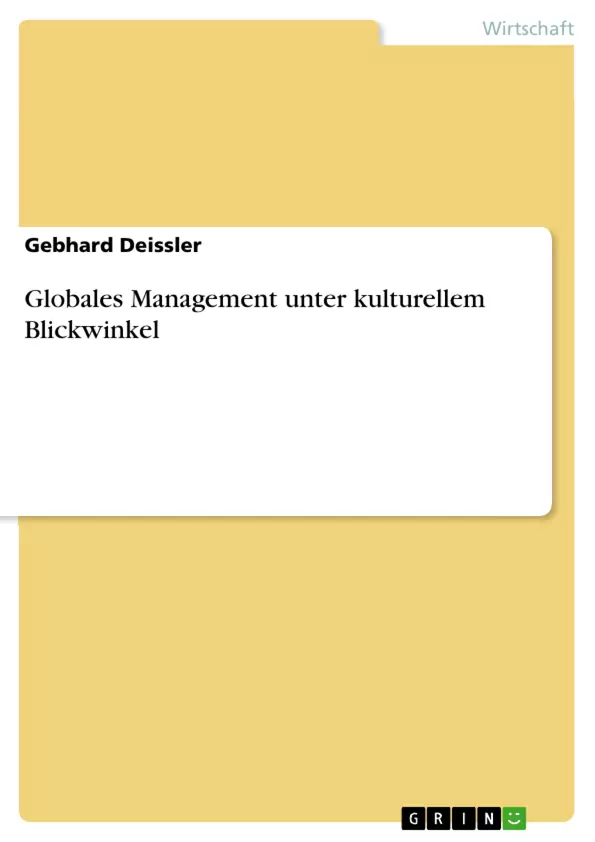Dieser aus zwölf Bausteinen bestehende Intensivkurs Globales Management und Kommunikation unter kulturellem Blickwinkel ist insofern innovativ, als dass er die heterogene interkulturelle Forschung rekapituliert und diese in einem Modell der Modelle Managementpraxis orientiert integriert. Diese holistische Kontextualsierung wirft ein neues Licht auf das global skalierte kulturgrenzüberschreitende Management in Weltwirtschaft, Weltpolitik und darüber hinaus. Die Multidimensionalität des Managements von Komplexität wird durch eine transkulturelle und transdisziplinär destillierte strategische Steuerdimension vereinfacht und effektiver gestaltet. Sie integriert nicht nur diverse kulturelle Wertepräferenzen anässlich interkulturellen Interfacings, sondern sie integriert auch den interkulturellen, sowie den emergenten transkulturellen Managementansatz im Lichte einer ganzheitlichen, dreifältigen noetisch-psycho-somatischen Architektur des Menschen. Die Integration der Wertepräferenzen, der Kulturmodelle und der Forschungsansätze, sowie der menschlichen Architektur und damit der Menschheit als solcher auf solider Basis der Erkenntnis stellen ein Leitmotiv dar.
Diese Erörterung in Deutsch mit englischen Komponenten wird, jenseits jeglichen salomonischen Anspruchs, nicht von einem Geist antagonisierender Rechthaberei, sondern von einem Esprit des komplementären „schauen wir uns einmal zusammen an, in welche Richtung sich der State-of-the-Art der Interkulturalität im Interesse aller globalen Akteure, sowie der Menschheit insgesamt, weiterentwickeln könnte“. Nachfolgend die einführende Darstellung meines Master Modell Entwurfs mit seinen Attributen:...
Inhaltsverzeichnis
- Einführung und Vorstellung des Master Modells
- EINE KULTURELLE STANDORTBESTIMMUNG
- Der Kulturstandort Deutschland
- Kultur innenpolitisch
- Kultur außenpolitisch
- Kultur gesellschaftspolitisch
- Kultur wirtschaftlich
- Eine nuanciertere kulturelle Standortbestimmung
- Kultur in der Arbeitswelt
- Kultur im institutionellen Umfeld
- Fazit
- Das Ziel
- Der Weg
- Die Methoden
- STRUKTUR UND KULTUR DES MENSCHEN
- Kulturdefinition
- Die Entstehung des Kulturprofils
- Bewusstseinsarchitektur und Kultur
- Architektur der kulturellen Ebenen in verschiedenen Tiefen
- Die Beziehung zwischen expliziter und impliziter Bewusstseinsarchitektur
- BEWUSSTSEINSARCHITEKTUR UND INTERKULTURELLE FORSCHUNG
- Kulturmodelle und interkultureller Paradigmenwechsel
- Geert Hofstede (achtziger Jahre)
- Trompenaars und Hampden-Turner (neunziger Jahre)
- Edward T. Hall and Mildred Reed Hall (neunziger Jahre)
- Brannen und Salk (2000)
- Der transkulturelle Ansatz (2000+)
- 360° transkulturelle Synergie
- Synopsis interkultureller Managementforschung
- INTRAPSYCHISCHES PROZESS- UND INTERKULTURELLES KOMMUNIKATIONSMANAGEMENT
- Das ORJI-Modell
- Der MIS-Faktor Prozess
- Die PIE-Metapher
- Multimodellierung intrapsychischer Prozesse
- VISUELLE SYSTEMATISIERUNG DER WELTKULTUREN
- Das Balkendiagramm der Weltkulturen
- Das bipolarisierte Kontinuum der Weltkulturen
- Weltkulturenkartierung
- Emergente Kulturprofile im globalen Management
- Epochales Bewusstseinsorientiertes (ALG)-Clustering
- Das Radardiagramm
- INTERKULTURELLE ENTWICKLUNG UND DIAGNOSTIK
- Geometrisierung und Numerisierung des interkulturellen Profiling und Matching
- Die Diagnostik des interkulturellen Anpassungsverlaufs
- Distanzdiagnostik
- Globale Mindsetdiagnostik
- Spezieller interkultureller Managementkompetenzerwerb
- Transnationale Manager
- Das Entwicklungsprofil unter globalem Blickwinkel
- Kultur und Bewusstsein: Die Bedingtheit der interkulturellen Entwicklung durch die psychologische Entwicklung
- Die Entwicklung transkultureller Intelligenz
- Der transkulturelle Profiler als Entwicklungsspirale
- GLOBALISIERUNGSMANAGEMENT
- Revuepassierung der Globalisierungsstrategien im weltweiten Vergleich unter transkulturellem Blickwinkel:
- Levitt Theodore
- Ohmae Kenichi
- Perlmutter Howard
- Adler Nancy
- Bartlett, Ghoshal and Birkinshaw
- Transnationales Management
- Vergleich der Globalisierungskonzepte unter transkulturellem Blickwinkel
- GLOBALES BUSINESS TEAM MANAGEMENT
- MANAGING GLOBAL NEGOTIATIONS
- PRAXOLOGIE: Von der Interkulturalität zur Transkulturalität. Eine Synopsis interkultureller Instrumente und Interfacingstrategien
- PRAXIS: Simulation, Rollenspiel und Fallstudie im intra- und interkulturellen Kontext
- BILINGUALES ENGLISCH - DEUTSCHES INTER- UND TRANSKULTURLELLES MANAGEMENT REFERENZWÖRTERBUCH
Zielsetzung und Themenschwerpunkte
Dieses Werk befasst sich mit dem Thema des globalen Managements unter dem Aspekt der Kultur. Der Autor erforscht, wie kulturelle Unterschiede die Arbeitswelt beeinflussen und welche Strategien für erfolgreiches internationales Management erforderlich sind.
- Kulturelle Standortbestimmung Deutschlands
- Struktur und Kultur des Menschen
- Bewusstseinsarchitektur und interkulturelle Forschung
- Intraphysische Prozesse und interkulturelle Kommunikation
- Visuelle Systematisierung der Weltkulturen
Zusammenfassung der Kapitel
Die ersten Kapitel des Buches befassen sich mit der Definition von Kultur und der kulturellen Standortbestimmung Deutschlands. Es werden verschiedene Modelle der interkulturellen Forschung vorgestellt und der Einfluss von Bewusstseinsarchitektur auf die Kultur erörtert. Die Kapitel befassen sich mit dem Konzept der transkulturellen Intelligenz und bieten Einblicke in die komplexen Beziehungen zwischen Kultur und Individuum.
Die folgenden Kapitel widmen sich der interkulturellen Kommunikation, dem Management von globalen Teams und den Herausforderungen der globalen Verhandlungsführung.
Das Buch beleuchtet die Bedeutung des interkulturellen Kompetenzerwerbs für Führungskräfte in der heutigen globalisierten Welt und bietet praktische Werkzeuge für die Bewältigung interkultureller Herausforderungen.
Schlüsselwörter
Die Schlüsselwörter dieses Buches umfassen globale Management, Kultur, Interkulturalität, Transkulturalität, Bewusstseinsarchitektur, interkulturelle Kommunikation, interkulturelle Kompetenzen, globale Teams, Management, Verhandlungen, transnationale Manager, transkulturelle Intelligenz.
- Citation du texte
- D.E.A./UNIV. PARIS I Gebhard Deissler (Auteur), 2010, Globales Management unter kulturellem Blickwinkel, Munich, GRIN Verlag, https://www.grin.com/document/162678



